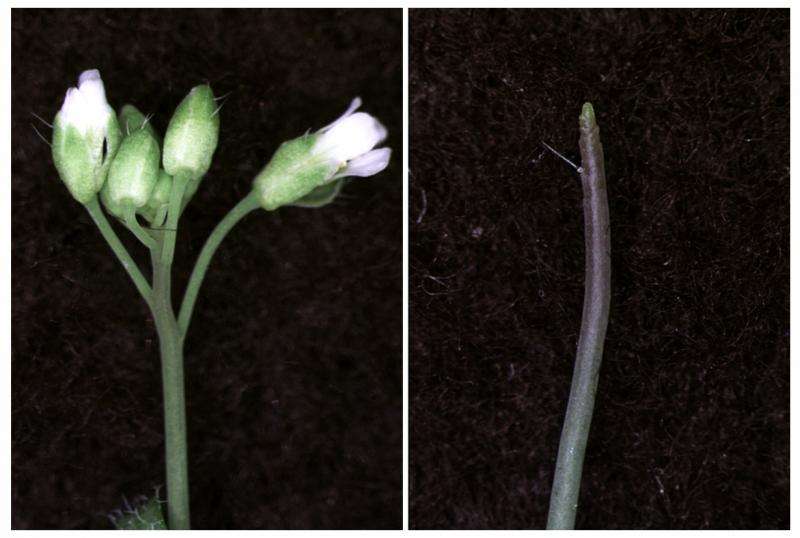Plant hormone 'switch' unravels chromatin to form flowers, biologists find

Because plants cannot pick up and move, they have evolved a plethora of strategies to cope with environmental stresses, whether they bring a harsh spell of drought or a browsing deer.
One of these strategies is plants' ability to continue growing new, diverse organs, including roots, branches and flowers, throughout their lifespan. But of course flowers don't develop just anywhere on the plant; they only grow from certain cells, which must receive a particular signal to begin the process. While researchers knew that flower formation was governed by the activity of the hormone auxin, they didn't understand precisely how it signaled the plant to form blooms.
Now University of Pennsylvania researchers have filled in the gaps and identified a hormone-mediated "chromatin switch" that directs a plant to form flowers. In the absence of auxin, genes that initiate flower formation are tucked away in tangled chromatin, a tightly packed bundle of DNA. But, in the hormone's presence, proteins are recruited to unravel chromatin and make the genes responsible for flower formation more accessible.
The findings could be useful in efforts to strategically boost flower formation as a means of increasing yield in agricultural crops. And the study's contribution to understanding basic mechanisms of chromatin regulation, which may be similar across species and even kingdoms of living things, could have implications for many biological processes, including human health.
"This one hormone auxin is very famous because it has many roles, in embryo, root and flower development, in vein formation, in growth—it's doing all of these things," said Doris Wagner, senior author on the work and a professor of biology in Penn's School of Arts & Sciences. "The question is always, How can one hormone do all these different things? Now we see that, by helping open up chromatin, it can allow a variety of other proteins to come in and initiative these different pathways. All of a sudden these very diverse processes are not so hard to explain anymore."
Wagner collaborated with Penn's Miin-Feng Wu, Nobutoshi Yamaguchi, Jun Xiao and Yi Sang as well as Bastiaan Bargmann and Mark Estelle of the University of California, San Diego.
Their research is published in the journal eLife.
In work published in 2013, Wagner and colleagues began to piece together how auxin regulated flower formation. They already knew that auxin activated the transcription factor MONPTEROS, and went on to identify that factor's direct targets, which included three genes involved in flower development.
But the researchers believed the process was not that simple because those genes were packed tightly away in chromatin, which would prevent them from being activated. There must be another factor that makes those genes available to be transcribed, the team reasoned.
"So we looked on purpose for proteins that are required for making flowers and were also chromatin regulators that might overcome this repressive environment," Wagner said.
Performing experiments in Arabidopsis, the researchers showed that plants with double mutations in SWI/SNF proteins, BRM and SYD, which are known chromatin remodelers, failed to initiate flower formation. Because they can't make flowers, these plants had pointy "pin-like" forms.
The team also showed that BRM and SYD, which are part of a chromatin remodeling complex, bound to the same locations as MONOPTEROS does in the regulatory regions of various genes required for flower development. They also demonstrated that MONOPTEROS physically interacts with BRM and SYD, likely recruiting them to the proper site in the chromatin.
Once at the proper site, the team showed that BRM and SYD, in the presence of auxin, reshape chromatin in a way that makes the flower-formation genes more accessible for transcription and expression.
Wagner's group next artificially guided BRM and SYD to the correct locations in the genome in plant cells. Those cells showed increased expression of flower formation genes, just as cells exposed to auxin did.
When they repeated this experiment in a mutant plant that normally fails to form flowers, they were able to coax it to develop flowers, almost identically to a normal plant.
"We were very surprised to see the flowers come back so dramatically," Wagner said. "And, though we didn't study other aspects exhaustively, it appears that this chromatin-remodeling complex may also rescue leaf formation and perhaps some other plant development processes regulated by auxin."
The findings suggest that this process could be strategically manipulated in order to pack more flowers on one plant, potentially increasing agricultural yields.
There are signs that the auxin pathway and these SWI/SNF proteins are present even in ancient plants, so the process of recruiting chromatin remodelers could be universal in plants.
Auxin is not made in humans, but, as Wagner noted, the chromatin remodelers her team studied are and are known to be tumor suppressors—proteins that, when mutated, can allow tumors to grow unchecked. Thus, it's conceivable that one could design a hormonal switch, using auxin, to regulate them.
More information: Miin-Feng Wu et al. Auxin-regulated chromatin switch directs acquisition of flower primordium founder fate, eLife (2015). DOI: 10.7554/eLife.09269
Journal information: eLife
Provided by University of Pennsylvania



















